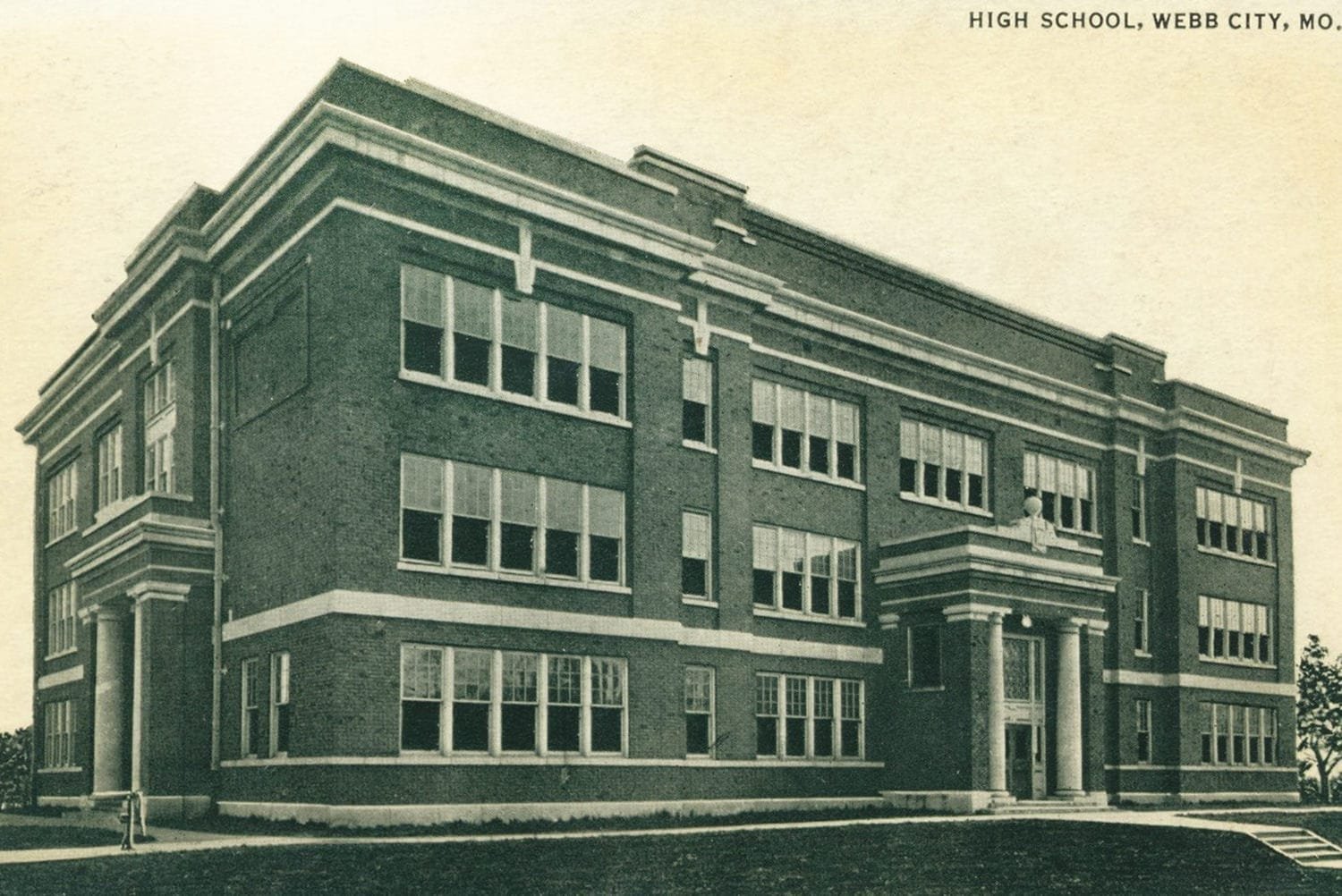
Webb City High School in 1912.
Ancestors, Legends & Time
Let’s once again, take a step back in time – actually two steps. The first is Larry Hayes’ memory from 1995 in which he recalls his memories of growing up in Webb City. The second is his mention of a previous article that included pictures of the old high school.
Thank you very much for pictures of the old Webb City High school, auditorium and library. They bring back so many wonderful memories of the good times we had and the many friends we made while in high school from 1931 to 1944.
We should be proud of those city fathers, who at the turn of the century dreamed of and planned for a great city. It seems all together proper that they began that process in 1911 with the building of a fine new high school along with additions to the several grade schools to accommodate a growing school population.
They could not have foreseen at that time a string of national disasters that would play havoc with their plans. The first major set-back for this progressive community was a world war to end all wars and soon thereafter severe cutbacks in the demand for lead and zinc. Those of us who lived on the north side of town were well acquainted with the hundreds of cement foundations scattered throughout the area where houses once stood.
Next came the stock market crash causing banks to close, farmers to lose their land, businesses to fail and cities to scramble to keep basic services in place. In Webb City, the junior high school was shut down with all students, seventh through 12th crowded into the new high school in an effort to reduce the number of teachers required. My father came to Webb City as the junior high principal just before this change was made. Salaries for teachers were drastically reduced, making it necessary for our family to move from a big house in town to a small farm where we could grow food for a family of 10. Because other teachers were also having a hard time making ends meet, my father provided plots of land for several of them to grow their own food.
As the great depression deepened, hard times engulfed the entire population as fields turned to dust and days turned dark as clouds of dust out of the west blocked the sun and dry heat dried up all our crops. Animals died for lack of food and water. Children cried for food and parents wept in despair. It seemed that no matter how hard we worked, without water for our pasture, garden and fruit trees, everything withered and died. We did have a deep water well and pumped water for the house, cows and chickens. But without hay and grain we kept only a few chickens for eggs and one cow for milk.
I started school in 1932 at Webster Elementary, first through sixth grade. I remember all of my teachers and many of my classmates such as Jim Bentley, John Potter and Ray Farris. There was a store just one block south of the school where several of us boys would gather to listen to the radio broadcast of baseball games involving such greats as Babe Ruth and Lou Gehrig.
Beginning with the seventh grade, students from all over town went to the high school building. What a great school we had in 1938. We had students who were eager to learn. Can students of today even imagine attending a high school where only two or three teachers had cars and no students drove a car to school or rode a bus.
My most vivid memory of our school building came during that first year. We had a very cold winter and our old farm house was drafty and cold, especially early in the morning. Lonnie Adams coached all sports in junior high and high school. We were to have our first basketball practice at seven o’clock on a very cold November morning. After walking 10 blocks to school, I was let into the west door by our janitor, Mr. Baker. I sat on the stairs to put on my shoes, waiting for our coach to arrive. You can’t imagine how great it felt to be in a building where even the floor was warm. Sometime later, Mr. Baker showed me through the entire building and explained how the heating system worked.
Just when everyone was going back to work on farms and in factories across the land, Hitler’s armies began their march into Europe and this nation had to gear up to fight WWII. At first our lives changed very little. Because we were poor, rationing of shoes, gas, sugar, etc. did not affect us. We did all pitch in to conserve scarce items and gather scrap iron and lead. Our teachers stressed the importance of science and math. May Aldridge offered special courses in slide rule and aeronautics. I spent many hours under her tutelage on these subjects in the room next to the school library and the study hall.
The school auditorium brings back many memories of class plays, operettas, choir practices and graduations. For most of us who were there on December 7th, 1941, we will never forget our President’s message of the Japanese attack on Pearl Harbor and from that day on, nothing was as important as the war effort. Our thoughts centered around those going off to war and our own future involvement.
Oh yes… we participated in sports and music. We dated, attended school dances and parties and we tried to study and make good grades. But when we learned that one of our teachers of the year before was killed in action and a number of our friends and relatives lost their lives, it was not the best of times.
My class had its 50th reunion in 1994. It was sure good to see so many of my friends from so long ago, but several of us expressed a wish that we could once again walk through our old high school building. Life has been good for most of us, perhaps because we were able to live through some rough times and still enjoy the experience.
As for Webb City and our city fathers, almost a century later, having been tested, they are continuing to dream those dreams of a stronger, more vibrant city in which to raise and educate future generations. We wish them well.
Larry Hayes, Class of ’44.

A lot of us appreciate the Bradbury Bishop Fountain, but Jeanne actually worked behind the counter making sodas while she was in high school. She knows everything about Webb City and is a member of the Webb City R-7 School Board.